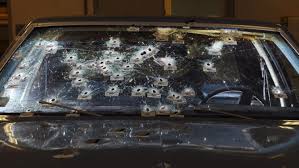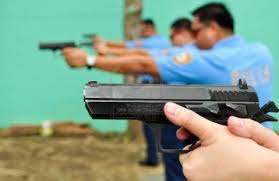Thousands dead, few prosecuted
Share
Explore Our Galleries
Breaking News!
Today's news and culture by Black and other reporters in the Black and mainstream media.
Ways to Support ABHM?
By Kimberly Kindy and Kimbriell Kelly, the Washington Post
Among the thousands of fatal shootings at the hands of police since 2005, only 54 officers have been charged, a Post analysis found. Most were cleared or acquitted in the cases that have been resolved.

Chevy Malibu riddled with bullets by Cleveland police after a chase. The unarmed couple inside were killed. Officer Michael Brelo, who fired 34 shots at the vehicle and then climbed on the hood to fire 15 more through the windshield, has been charged with 2 counts of voluntry manslaughter.
…Some 54 officers were charged over the past decade for fatally shooting someone while on duty, according to an analysis by The Washington Post and researchers at Bowling Green State University. This analysis, based on a wide range of public records and interviews with law enforcement, judicial and other legal experts, sought to identify for the first time every officer who faced charges for such shootings since 2005. These represent a small fraction of the thousands of fatal police shootings that have occurred across the country in that time.
In an overwhelming majority of the cases where an officer was charged, the person killed was unarmed. But it usually took more than that.
When prosecutors pressed charges, The Post analysis found, there were typically other factors that made the case exceptional, including: a victim shot in the back, a video recording of the incident, incriminating testimony from other officers or allegations of a coverup.
Forty-three cases involved at least one of these four factors. Nineteen cases involved at least two…
But even in these most extreme instances, the majority of the officers whose cases have been resolved have not been convicted, The Post analysis found.
And when they are convicted or plead guilty, they’ve tended to get little time behind bars, on average four years and sometimes only weeks. Jurors are very reluctant to punish police officers, tending to view them as guardians of order, according to prosecutors and defense lawyers…
Among the officers charged since 2005 for fatal shootings, more than three-quarters were white. Two-thirds of their victims were minorities, all but two of them black…
Most of the time, prosecutors don’t press charges against police — even if there are strong suspicions that an officer has committed a crime. Prosecutors interviewed for this report say it takes compelling proof that at the time of the shooting the victim posed no threat either to the officer or to bystanders…
In a third of the cases where officers faced charges, prosecutors introduced videos into evidence, saying they showed the slain suspects had posed no threat at the moment they were killed. The videos were often shot from cameras mounted on the dashboards of patrol cars, standard equipment for most police departments…
Stinson, a Bowling Green criminologist, said it is often the case that questionable police shootings are an act of passion. Sometimes, he said, the encounters start with something as simple as a traffic stop and escalate when someone fails to obey the officer’s directions…
Of the 54 officers who were charged for fatally shooting someone while on duty over the past decade, 35 have had their cases resolved. Of those, a majority — 21 officers — were acquitted or saw their charges dropped…
As hard as it is for prosecutors to win a conviction or an admission of guilt, it’s even harder to persuade a judge or jury to give an officer significant prison time.
For the nine officers convicted in state prosecutions, sentences ranged from six months to seven years, The Post analysis shows. One of the other cases, the shooting death of the 92-year-old woman in Atlanta, was taken up by federal prosecutors, who added civil rights violations to manslaughter charges and won stiffer sentences, ultimately sending the two convicted officers to prison for six and 10 years.
Six of the officers who faced state prosecutions were convicted after going to trial. On average, they got 3 1/2 years…
Read the full article here.
Read more Breaking News here.










Comments Are Welcome
Note: We moderate submissions in order to create a space for meaningful dialogue, a space where museum visitors – adults and youth –– can exchange informed, thoughtful, and relevant comments that add value to our exhibits.
Racial slurs, personal attacks, obscenity, profanity, and SHOUTING do not meet the above standard. Such comments are posted in the exhibit Hateful Speech. Commercial promotions, impersonations, and incoherent comments likewise fail to meet our goals, so will not be posted. Submissions longer than 120 words will be shortened.
See our full Comments Policy here.